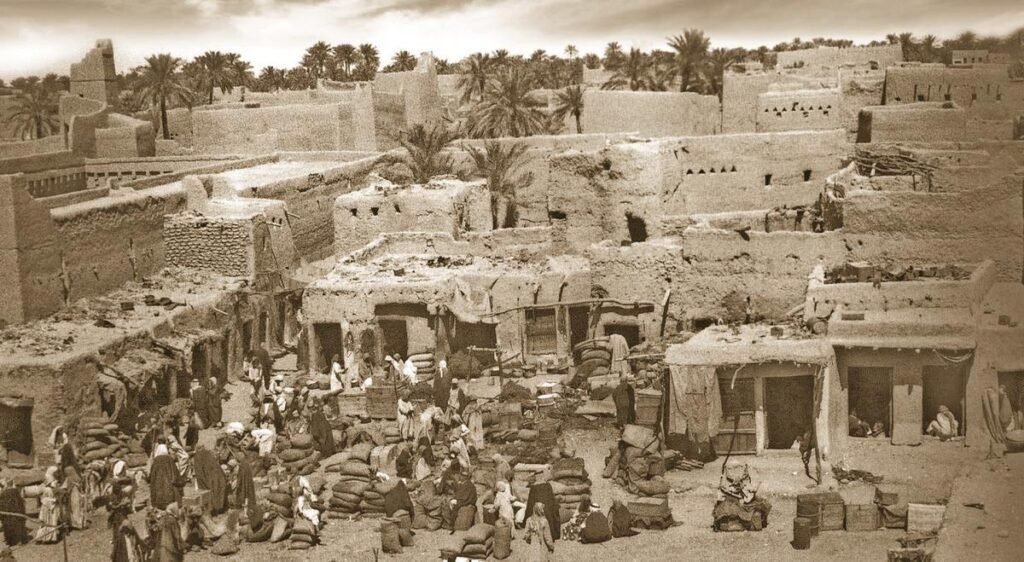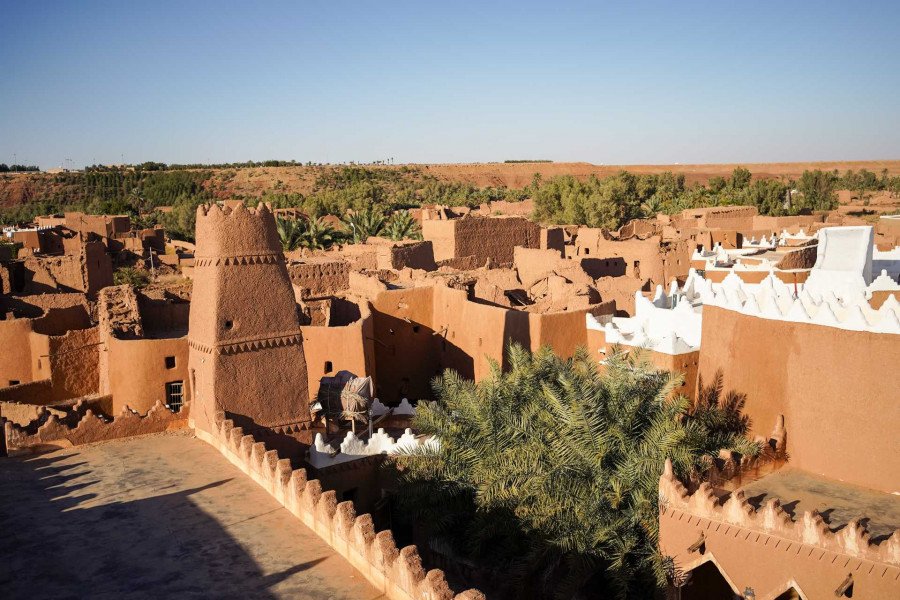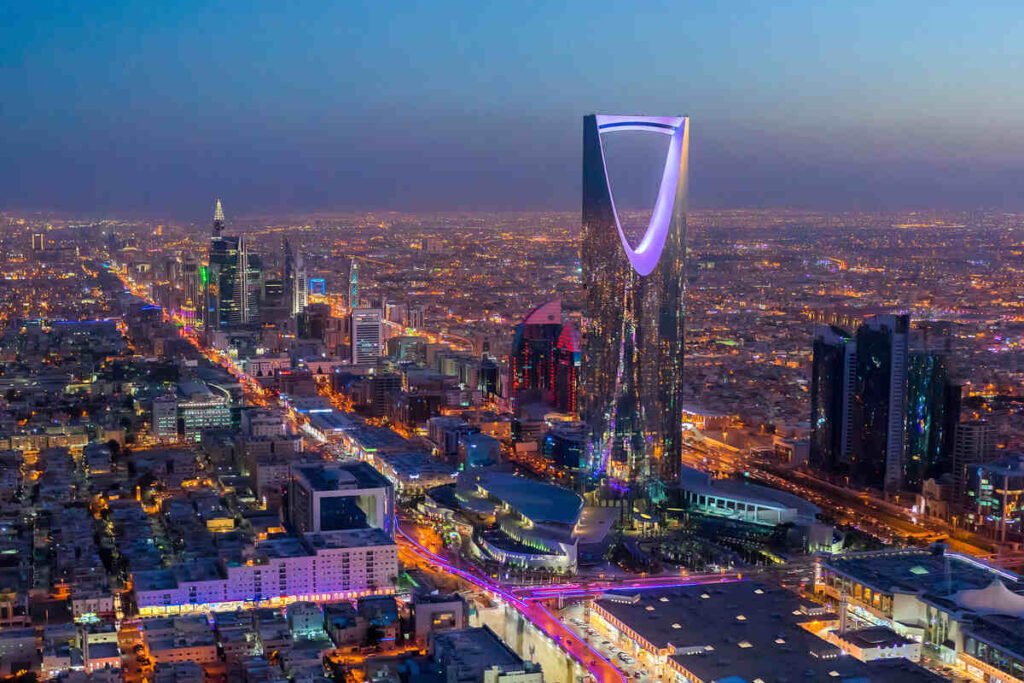Riyadh Then and Now
Riyadh Then
Riyadh, the capital city of Saudi Arabia, derives its name from the Arabic word rawḍah, meaning “gardens” or “meadows.”
This name reflects the city’s origins, as it is situated at the meeting point of the Wadis Ḥanīfah and Al-Baṭḥāʾ, which historically provided natural fertility to the area.
Riyadh’s landscape, a mix of desert terrain and vibrant urban development, offers a striking visual contrast, particularly at night.
From above, the city appears as a glowing sea of lights, resembling a blooming garden amid the vast, dark desert.
This scene evokes the concept of lush meadows flourishing in a place where life seems to emerge from the arid surroundings.
The contrast between the city’s bright illumination and the surrounding desert serves as a modern-day reflection of the city’s name and its historical connection to fertility and growth in an otherwise barren landscape.

Riyadh History
Riyadh, the capital city of Saudi Arabia, has a rich history that spans several centuries, evolving from a small fortified village into a modern metropolis.
Initially, the area was home to the ancient city of Ḥajr, which served as the capital of the Al-Yamamah region during the pre-Islamic and early Islamic eras.
The city’s location, surrounded by fertile land and a network of valleys, provided a natural advantage for farming and trade.
The availability of water, particularly from Wadi Ḥanīfah, played a significant role in the development of Riyadh, supporting the cultivation of dates and other crops and contributing to the city’s growth as a commercial hub.
Related Article: Abu Dhabi Then and Now
During the 17th century, the settlement that would become Riyadh was a small, fortified village.
It was part of a chain of oasis towns along Wadi Ḥanīfah, which provided the necessary resources for survival and growth.
The city’s role in the larger context of Arabian politics began to take shape in the 18th century.
In 1737, Deham ibn Dawwas of Manfuha took control of the area, fortifying it to consolidate various oasis towns under a single city wall.
Related Article: Doha Then and Now

Riyadh’s strategic location and fertile environment contributed to its significance, as it became a center of regional power in the centuries that followed.
By the early 19th century, Riyadh was at the heart of the political struggles that defined the early history of Saudi Arabia.
It became the capital of the First Saudi State in 1824 but was later captured by the Ottomans in 1818.
After a period of decline, Riyadh was retaken in 1902 by Abdul Aziz ibn Saud, who established the Second Saudi State.
Related Article: Ahmedabad Then and Now
This marked a pivotal moment in Riyadh’s history, as the city became the center of Abdul Aziz’s campaign to unite the Arabian Peninsula.
Riyadh remained the seat of power as he founded the Kingdom of Saudi Arabia in 1932.
Riyadh’s transformation into a modern city accelerated in the mid-20th century, especially after it was designated as the capital of the newly formed kingdom.
King Saud, who ruled in the 1950s, made it a priority to modernize Riyadh, with new neighborhoods and infrastructure being developed.
Related Article: Hyderabad Then and Now
The city’s population surged during this time, and its layout began to take shape with the introduction of grid-based streets, which facilitated urban expansion.
In the 1980s and 1990s, Riyadh underwent rapid economic and infrastructural growth, particularly in the commercial and residential sectors.
This expansion was driven by Saudi Arabia’s oil wealth, with Riyadh becoming the nation’s economic and political hub.
Today, the city continues to grow, with significant development projects designed to support its position as a key player in the global economy.
Related Article: Bengaluru Then and Now
Riyadh Now

Riyadh, the capital and largest city of Saudi Arabia, stands as a thriving urban center located in the heart of the Arabian Peninsula.
Situated on the eastern part of the Najd plateau and surrounded by the vast an-Nafud desert, Riyadh enjoys a strategic position both geographically and politically.
Its elevation of 600 meters (2,000 ft) above sea level contributes to a unique climate compared to other cities in the region.
Related Article: Chennai Then and Now
Over the past few decades, Riyadh has undergone rapid urbanization, evolving from a small walled town into a sprawling metropolis.
This transformation was catalyzed by the dismantling of the city’s fortifications in the 1950s, marking the beginning of a series of expansions and modern developments that continue to shape the city’s infrastructure and skyline.
Today, Riyadh is a vibrant hub of culture, commerce, and governance, with a population exceeding 7 million people as of 2022.
Related Article: Fukuoka Then and Now
This makes it not only the most populous city in Saudi Arabia but also the third most populous city in the Middle East and the 38th largest in Asia.
The city’s economic growth is closely tied to Saudi Arabia’s oil wealth, but Riyadh has diversified its economy, with major investments in sectors such as technology, real estate, education, and tourism.
This broad economic base supports Riyadh’s role as a regional leader in business and innovation.
Related Article: Nagoya Then and Now
As a major global city, Riyadh attracts around 5 million tourists each year, ranking as the 49th most visited city in the world. Its appeal lies in a blend of traditional Saudi culture and modern attractions.
The city is home to a wealth of cultural landmarks, historic sites, and luxury shopping centers, alongside modern architectural wonders like the Kingdom Centre Tower and the Riyadh Metro system currently under development.
Additionally, Riyadh is an important religious and political center, as it houses the royal family and key government institutions.
Related Article: Osaka Then and Now
Riyadh is also a city of strategic importance, not just within Saudi Arabia but across the Middle East.
The city’s political landscape is governed by the Municipality of Riyadh, which oversees its urban districts, and the Royal Commission for Riyadh, headed by the Governor of Riyadh Province.
Related Article: Busan Then and Now
Riyadh’s influence is set to increase even further as it prepares to host Expo 2030, a major international event that will bring global attention to the city and its ongoing development.
This makes Riyadh the second Arab city to host the Expo, following Dubai in 2020, showcasing its growing prominence on the world stage.
Related Article: Taipei Then and Now
FAQs
No, alcohol is strictly prohibited in Riyadh and throughout Saudi Arabia due to the country’s strict interpretation of Islamic law.
Girls of Riyadh is a novel by Rajaa Alsanea that explores the lives of four young women in Riyadh. It delves into their struggles with love, friendship, and societal expectations in a conservative society.
The cohabitation of unmarried couples is illegal in Saudi Arabia, including Riyadh. It is not allowed for unmarried individuals, including foreign visitors, to live together.
Riyadh is the largest city in Saudi Arabia, both in terms of population and area.






























